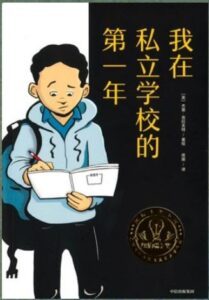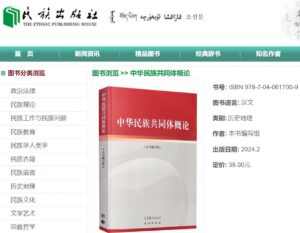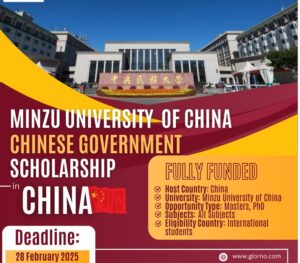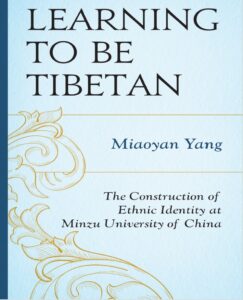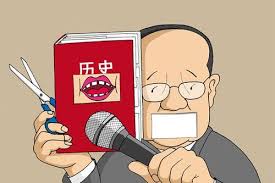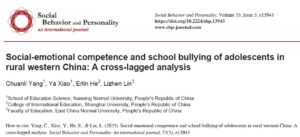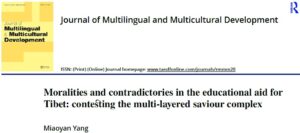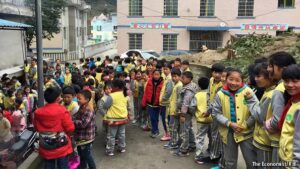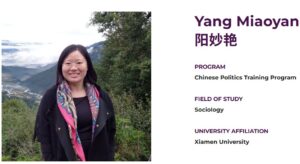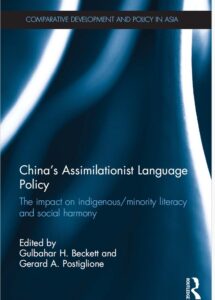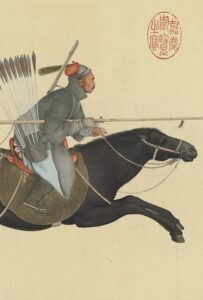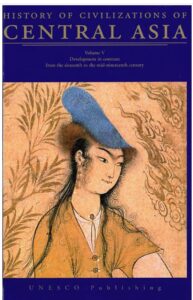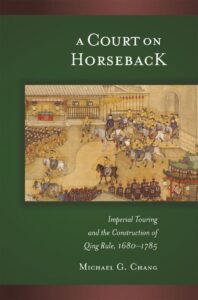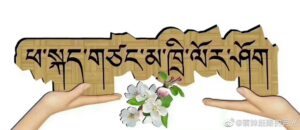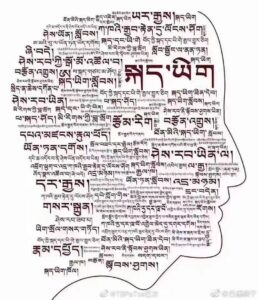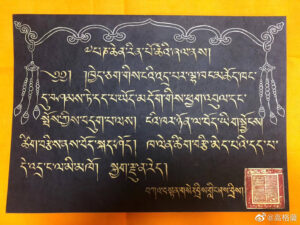Cancellation of schooling in Tibetan language, culture, civilisation as lived, embodied realities in the lives of Tibetans, has been the policy core of China’s ethnic policy 2.0 for the past 15 years. Yet China finds it hard to shift the mentality of those stubborn red-faced Tibetans. Suffocating Tibetan identity, social engineering of Tibetans so they identify first and foremost as Chinese, is proving difficult.
In April 2025 China moved decisively to close the last vestige of respect for Tibetan language and culture in the education system, decreeing that all the minority nationality minzu universities from now on must teach -across all disciplines- a Han centric caricature of the histories and destiny of both China and Tibet. From age five to 25, in primary, secondary schools and now university, conformity to China’s racist assimilation agenda is now compulsory.[1]
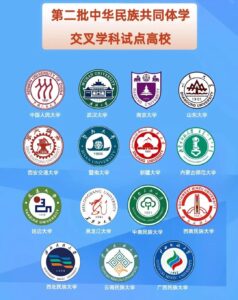
THE ZHONGHUA CHINESE RACE AS THE TOP OF THE PYRAMID OF CIVILISATION
Ethnic policy 2.0 is unapologetically assimilationist, full of rhetorics of all of China as a singular people, with a unique and common culture and destiny. Belonging to an ethnic group is merely a personal choice, with no legal status or territorialised autonomy, and no role in public life beyond essentialised ethnic dress to be compulsorily worn on official occasions requiring displays of diversity.
A relentlessly assimilationist turn resulted in the new boarding school system, which takes children much younger than did the Neidi Xizangban hinterland schools, in the expectation that a deep shift in identity can be engineered.
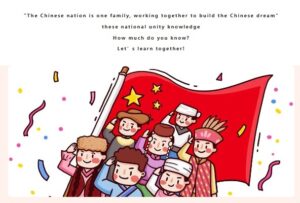
However, that left, until 2024, the ongoing problem of Tibetan students enrolled in the Minzu University system, continuing to seek to reconnect with cultural roots denied to them in their Neidi Xizangban schooling. If assimilation must succeed, the minzu universities must also be made to shift to the master narrative of there being only one China, one Chinese race, one Chinese language, history, culture, heritage.
Fortunately for the assimilationists, there is now, at the top of the system, a relentless driver of this assault on the minzu universities, an insistent demand that they teach, to all students, a greatly simplified history of China that incorporates all ethnic minorities as variants of the singular triumphant story of unbroken continuity for 5000 years.
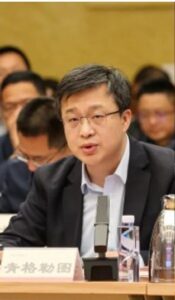
Pan Yue is the man. Pan Yue is a warrior, energetically and relentlessly pushing ahead in the long battle to make China unitary, all ethnic identities absorbed into one over riding loyalty, to the party-state and the Zhonghua minzu, the one Chinese race.
As a senior leader Pan Yue took on the work of building “ecological civilisation”, a policy shift at first announced, in 2007, as a feelgood but empty slogan, given teeth later with the backing of Xi Jinping, pushing for China to be seen afresh as a global leader in designating protected areas and promoting the technologies of decarbonisation. During his time as vice-minister of environmental protection from 2008 to 2015, Pan noted that local and provincial governments often subverted environmental laws and openly protected their biggest corporate polluters. Pan Yue was the teeth, unafraid to bite provincial protectionists defending their vested interests in owning polluting factories and power stations, seizing natural lands and profiting from classifying them as urban, for their developer friends.
Pan Yue was such an effective attack dog, environmentalists worldwide heaped praise on him.[2] In hindsight, their plaudits took rather too literally China’s pledging “arduous struggle to construct ecological civilisation” as signifying a recognition of limits to growth, when Xi Jinping was actually demanding “mobilizing hundreds of millions of workers to build a great country and advance national rejuvenation.”[3]
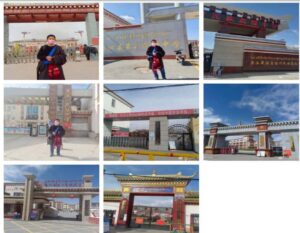
COMPLETING THE ASSIMILATIONIST MAKEOVER
Now almost all Tibetan children, from a very young age, must live in boarding schools which 24/7 push the superiority of all that is Han Chinese, and label the inferiority, irrelevance, backwardness, uselessness of all that is Tibetan. Yet the system is still not complete, if in university Tibetans yearn and search to reconnect to Tibet. That is a failure, and it much be rectified.
Henceforth, there is to be no backsliding. From age five to 25, from preschool to university graduation, the messaging must be consistent, insistent, assimilated into the values and beliefs of every student. This is ethnic policy 2.0.
Pan Yue is now Vice Minister of the United Front Work Department of the CPC Central Committee, Director and Party Secretary of the National Ethnic Affairs Commission. He now deploys his energies to collapsing ethnic identity. On 24 June 2022, he was appointed as the director of the National Ethnic Affairs Commission (NEAC), which since 2018 is within the CCP’s United Front. He was promoted to become a full member of the CCP Central Committee after the 20th CCP National Congress in October 2022.
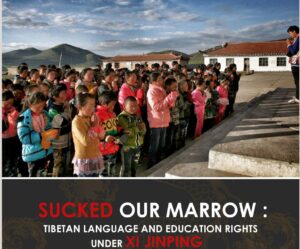
Forcing the pace of assimilation requires arduous struggle; Pan Yue is a busy man. If everyone must identify first and foremost as Chinese, belonging to the Zhonghua minzu Chinese race, there must be a master narrative of how to define essentialised Chineseness, a textbook that oversimplifies the history of China, editing out all the conflicts, failures, breaks and discontinuities, reducing all to a straight line of 5000 years of continuous, unbroken Chinese civilisation, unique.
Pan Yue wrote the textbook, and now pushes energetically for it to be studied by all university students, especially those enrolled in the many universities specialising in training ethnic minority students.[4]
The price of imposing a narrow, rigid, chauvinist travesty of Chinese and Tibetan identity, history and relations will be enormous. Four or more decades of minzu universities across China enabled students and teachers, within limits, to explore and publish curricula, training programs, research reports and dissertations honouring ethnic diversity, differing historic arcs, the rich variety of identities and cultures of the many ethnic minorities.
From now on, all teaching, all texts, all products of the minzu university system must conform to Pan Yue’s narrow, Han triumphalist agenda, a great loss.[5]
A WARRIOR OF RECTIFYING MINDS
Pan Yue is a busy man, doing inspection tours of the universities controlled directly by the National Ethnic Affairs Commission, demanding his textbook be taught to all students, whatever their academic discipline, a compulsory course in the correct line, with exams. This is the culmination of a 20-year assimilation trajectory program that starts at age five, to ensure no more divided loyalties within the hearts of the Tibetans who must administer Tibet, since so few Han want to stay in Tibet for long.
Minzu University of China (MUC), ཀྲུང་ཧྭ་མི་དམངས་སྤྱི་མཐུན་རྒྱལ་ཁབ་ཀྱི་རྒྱལ་ཁབ་མི་རིགས་དོན་གཅོད་ཨུ་ཡོན་ལྷན་ཁང་ in Beijing, is Pan Yue’s operational base.
Pan Yue has designed what he calls the 1+15 method of ensuring compliance. The 1, is MUC, in the lead, setting the example, commanding a batch of 15 ethnic minority universities to fall into line. The first iteration was in 2024, the second batch was announced 21 April, 2025, including all three of the top universities for Tibetans, on the fringes of Tibet, in Gansu Lanzhou Northwest University for Nationalities, 西北民族大学; in Sichuan Chengdu Southwest University for Nationalities; and in Yunnan Kunming Yunnan University for Nationalities 云南民族大学.
In his inspection visits of these core enforcers of assimilation Pan Yue has made clear what is required. In 2023, at the Lanzhou campus so many Tibetans had studied in, he headlined a symposium, bluntly demanding compliance with “forging the consciousness of the Chinese national community. It is necessary to establish a correct view of the country, history, ethnicity, culture, and religion, strengthen the “baton” role of the national outlook assessment index system, and integrate the sense of forging the Chinese national community into the whole process of running schools, governing schools, teaching and educating people. It is necessary to give full play to the advantages of disciplines and talents, deepen the study of the history and culture of the northwest region, especially the sinicization of religions in our country, thoroughly publicize and explain the five outstanding characteristics of Chinese civilization, vigorously carry forward the excellent traditional Chinese culture, and guide teachers and students of all ethnic groups to enhance the “five identities”. It is necessary to consciously serve the overall situation of the party’s ethnic work, and take the initiative to participate in the construction of a theoretical research system, a system of policies and regulations, and a propaganda and education system for forging the consciousness of the Chinese national community. It is necessary to strengthen the party’s overall leadership and strengthen the political and organizational functions of party organizations at all levels in forging a firm sense of the Chinese national community.”[6]
RECTIFICATION ENFORCEMENT
In August 2024 Pan Yue inspected the Southwest University for Nationalities in Chengdu, a magnet for aspirational Tibetans, where he “held a symposium to listen to the school’s work report and opinions and suggestions from all parties” before issuing his demands: “Pan Yue emphasized that, facing the future, Southwest University for Nationalities should not only run higher education well, but also highlight its special role in forging a strong sense of community of the Chinese nation. It is necessary to actively promote the construction of the theoretical system of the Chinese nation community, focus on studying and interpreting the history of exchanges and integration of ethnic groups in the southwest region with the direction of enhancing commonality, and tell the story of the Chinese nation community well both internally and externally. It is necessary to accelerate the optimization and adjustment of disciplines, focus on accelerating the construction of the Chinese nation community…. focus on creating special disciplines such as governance of the southwestern border areas, exchanges and integration of ethnic groups in the Han-Tibetan-Qiang-Yi corridor, and conduct in-depth research on the sinicization of Tibetan Buddhism…… focusing on forging a strong sense of community for the Chinese nation, adhering to the fundamental task of cultivating morality….. Southwest University for Nationalities has inherited the red gene of “loyalty and dedication to the Party and the country“[7]
These ethnic universities were originally intended to chart a middle way between mother tongue and conformity to Han centric party-state nation-building policies. Now their mission is a one-way mandatory transitioning of students, cancelling inherited identity, to be replaced by the innumerable slogans of forging the consciousness of the single Chinese national community.
If these colleges fail to comply, do they, in Beijing’s eyes, serve any purpose? They have now quickly complied. The journals of these prestigious minzu collages all now begin with a section on forging the consciousness of the Chinese national community. That means repetitive regurgitation of official slogans, performative declarations of being aligned with the new correct line, and little other content. Deadening. A closing of minds, a loss of fresh ideas.
An example: a 2024 report focussed on the remote, mountainous Myanmar/China border, where Burmese minorities try to flee being shot by the attack aircraft China supplies to the Burma military. There is now an effort (as with border villages in Tibet) for “construction of a community of responsibility of “guarding the territory, defending the territory and protecting the territory” by the special border-guarding team in Lushui City so as to promote the border residents to focus on the construction of a community of a shared destiny through a shift from “pursuing the personal interests” to “safeguarding the national interests.”[8] Assimilating to embrace the party-state agenda is what is now required everywhere.
OPPOSE HISTORICAL NIHILISM, OPPOSE WESTERN THEORIES
Assimilation czar Pan Yue has other battles to fight as well. He is insistent that China’s unique approach repudiates Western ideas about ethnic groups, concepts that cannot be applied to China. And he also must battle any suggestion China’s unbroken 5000 years of continuity were broken by the Manchu invasion and conquest of China in the 17th century, resulting in the 270 years of alien rule: the Qing dynasty. More on that wicked problem later.
China’s Communist Party has since its formation adopted many Western ideas, notably Marxism and the Soviet model. Ethnic policy, in the 1960s, was based on Soviet-style territorial autonomy privileging specified ethnicities, foundational to 20th century ethnic policy 1.0.
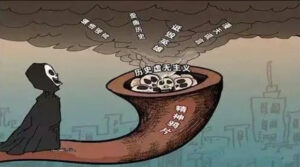
Ethnic policy 2.0, in this century, is based on standard Western urban melting pot multiculturalism sociology, that refuses territorialised legal autonomy, instead depicting ethnic identity as merely the arbitrary personal choice of individuals, with no role in the public sphere. For China, this is a way of trivialising ethnicity, removing it from any legal status; a move reinforced throughout Tibet by reclassifying what had been designated Tibetan autonomous prefectures and counties, to become municipalities, which by definition provide no special status to any particular ethnicity.
Yet Pan Yue is insistent that China is unique, owing nothing whatever to Western concepts. This fits the wider nationalist agenda that insists China owes nothing to anyone. This narrow closing of minds is critiqued by some Chinese scholars: “The rhetoric of ‘self-confidence’, heavily promoted by official media; the stream of aggressively nationalistic online commentary; the relentless expansion of the ‘competition first’ mindset; the near-systemic indifference to vulnerable groups across society—all this suggests that our society has gone a long way down the road of narrow market utilitarianism.
“We might come to believe that learning from the West was a mistake and that we should return to ‘the East’; that our own system is best after all. We might conclude that notions like international justice and world peace are all nonsense; that the unchanging pattern of world power since ancient times has been the law of the jungle, where the strong prey on the weak. If that’s the case, shouldn’t we strive to become the dominant force in the jungle? And if that means baring our teeth and roaring at weaker neighbours, why should we hesitate? This way of thinking could extend into domestic questions. If international relations are governed by the survival of the fittest, then isn’t it natural for our own society to be rigidly hierarchical, with the winners taking all? If that’s how things have always been, and always will be—just as the sun rises every day in the east—then what reason could there be to criticize it?”[9]
However, Pan Yue now fights to repudiate any suggestion of Western influence. In a March 2025 article in the CCP’s top journal of ideology, Qiushi, Vice Minister Pan Yue explains: “Strengthening the consciousness of the Chinese national community is an important part of Xi Jinping’s cultural thought and the core essence of Xi Jinping’s important thoughts on strengthening and improving ethnic work, pointing the way forward for the Party’s ethnic work in the new era… clearly proposing the major original thesis of strengthening the consciousness of the Chinese national community. This thesis has been established as the main line of the Party’s ethnic work and various tasks in ethnic regions in the new era, enriching and developing Marxist ethnic theory, and consolidating and expanding the correct path of solving ethnic issues with Chinese characteristics.”
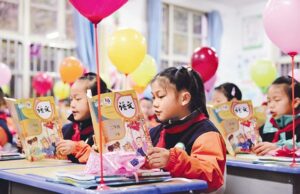
Pan Yue’s article in Qiushi is decorated with pix of happy minority Miao girls in primary school chanting in unison from their Mandarin Chinese textbooks.
But there is much more that must be accomplished if the historic inevitability of assimilation is to be a uniquely Chinese theory generated by China’s uniqueness. Pan Yue tells us “to accelerate the formation of China’s own historical, discourse and theoretical system of Chinese national community, in recent years, the State People’s Committee, in conjunction with the Ministry of Education, has guided the commissioned universities to solidly push forward the comprehensive integration of General Secretary Xi Jinping’s important ideas on strengthening and improving national work into discipline construction, especially to break through the limitations of knowledge of a single discipline, comprehensively applying the theories and methods of multiple disciplines such as Marxist theory, philosophy, history, ethnology, sociology, etc., and focusing on the construction of the theoretical system of the Chinese national community, and achieving positive results in theoretical research, education and teaching, and talent training.”
Talent training means training a new cohort of teachers to teach the new assimilationist curriculum, which will take years. The assimilationist agenda is yet to reach high gear.
HOW ETHNIC POLICY 1.0 ACTUALLY WORKED, IN THE SCHOOLS
Until this decree it seemed the master stroke for radically disrupting the transmission of Tibetan culture and language, from one generation to the next, was the calculated splitting of Tibetan families, with compulsory education for all Tibetan children, dislocated to urban boarding schools where tuition in almost all subjects is in standard Chinese.
Not only were many big new boarding schools built in county and prefecture towns and cities, from about 2010 on village schools were closed, and enforcement of China’s compulsory education policies intensified. The bold aim was to produce a new generation schooled not only in putonghua Chinese fluency, but in contemporary, consumerist, aspirational Han Chinese identity, seeing Chinese culture as dynamic, forward looking, full of opportunity to get rich, window to the world; with Tibetan culture and language at best an archaic window to the past, of little practical use.
In practice, this calculated splitting of families had the predictable outcome, recognisable from the sad histories of Canada’s residential boarding school system for indigenous peoples, Australia’s stolen generations, US Indian reservation system, of emotional stunting. Children spending their earliest years in not only their immediate nuclear family but in the wider care of grandparents and villages, experience plenty of responsiveness to their many emotions.
Not so in institutionalised boarding schools staffed by Han Chinese whose civilising mission is to inculcate more than a new language, nothing less than a new identity which is to be absorbed, accepted, believed, embraced by the child. In any such total institution, there is neither sufficient staff, nor focus on ameliorating loneliness, isolation, confusion, withdrawal, alienation leading to editing out, shutting out emotions, because they become traumatically painful when routinely ignored or trivialised. Dislocation results in a heavy price.
A new generation grows up unable to connect, unable to form deep relationships, unable to experience deep feelings. This has been amply researched in Canada, Australia and the US, where a lasting legacy of intergenerational silences and denial repeats and repeats. Increasingly, ethnographic fieldwork in China shows the same dehumanising trend.[10]
It is not only a very different language taught in these centralised schools. The entire curriculum is inflected with current jargon and propaganda slogans of China’s growth, dynamism, wealth creation opportunities, and children quite young are expected to memorise and performatively reproduce many of the vague slogans of Xi Jinping Thought.
Even during school holidays, when children can briefly return to family, children don’t know how to talk to parents, and parents dare not question what children say for fear of being innocently reported when the children return to school. To expect five-year-olds to negotiate two radically differing world views expects too much. This is much more than code switching between languages. These days, in village life when the children return for a few weeks, a mishmash of Chinese and Tibetan is usual. Tibetans call this ramalug, literally neither sheep nor goat, but are powerless to do anything.
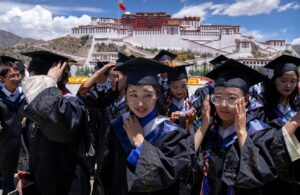
ENGINEERS OF THE HUMAN SOUL
Instilling into a new generation a wholly new worldview, expressed through a new language, is an arduous, long term task the party-state has set itself, but the party-state’s fear of insecurity is now so strong, government at all levels is committed to the “self-revolution” required of each child.
Partly this is because previous civilising missions, over several decades, largely failed to effectively make Tibetan language and culture irrelevant, obsolete. The intimate bonds within families are irreplaceable. It is not hard to notice how Han Chinese deal with each other instrumentally, transactionally, as counterparties; while Tibetan culture manifests greater priority for kindness, compassion, tolerance, flexibility.
For decades, Tibetan families have had the option of sending children who get good marks in school off to elite inland (Neidi Xizangban) schools, usually middle and senior schools, not primary. Chinese sociologists’ fieldwork reports in depth the outcome. China invested in these Neidi Xizangban schools, in the hope of forming a substantial cadre corps, imbued with Chinese values, who would on graduation return to Tibet and run it, in keeping with the national ideology, the outlook and values of the Han cadres staffing local government offices.
The highest scoring young Tibetans could go on to further elite training, at one of the universities for minority nationalities, in capital cities of many provinces.
LIP SERVICE BILINGUALISM
For decades, the slogans of ethnic policy emphasised bilingual education, and in the 1980s and more so in the 1990s it was possible to graduate from a Normal University teacher training college, as a professional teacher of Tibetan language, having done your studies almost entirely in Tibetan.
These gains are now cancelled, at university level, as well as in the primary and secondary schools. This is what is now lost: “Tibetan bilingual education in China includes two models: in the first model, or zangdan (ཁྲིད་ཐབས་རིགས་དང་པོ། 一类模式, 藏单), the medium of instruction is Tibetan with the exception of Chinese and English classes; in the second model, or zangjia (ཁྲིད་ཐབས་རིགས་གཉིས་པ། 二类模式, 藏加), the medium of instruction is Chinese with the exception of Tibetan and English classes. The practice of bilingual education varies across Tibetan regions, and there is always a gap between policy and practice. It should be noted that “Tibetan” in bilingual education can be taken in any dialect, Kham, Amdo, or Utsang.”[11]
The introduction of ethnic policy 2.0 in the early years of this century maintained the rhetoric of bilingual education, but of the two languages one was heavily favoured, the other largely bypassed and ignored.[12] This shift was backed by the law of 2000 mandating standard Chinese as the common tongue everyone must learn and speak; reinforced by the dominance of Mandarin in wealth creation and popular culture.[13]
So sociology fieldwork done early in the second decade of the 21st century took up a distinction, made clearly and straightforwardly in Chinese, between min kao min meaning “minority students who had some form of bilingual instruction prior to entering the university” and min kao han, meaning “minority students who had been educated through a Chinese-only curriculum prior to entering the university.” Within the min kao min, there were three distinct trajectories that had led to Tibetans enrolling in the elite Minority Nationalities University in Beijing (now officially Minzu University of China, MUC).
For decades, the choice of whether a child went to a Neidi Xizangban school in a hinterland province, dislocated from family, was a difficult choice to be made not by the dictate of the state, but by parents. It was an agonising choice. “A nuanced calculation of benefits and costs is underpinning the decision-making process. First, both the moral logic and sense of responsibility among Tibetan parents are personally and socially constructed, influenced by the state’s social engineering of state-building and education. Second, the temporality of compromise is a tactic employed by Tibetan parents to respond to the Han-centric dislocated boarding schooling provided by the interior Tibetan classes (ITC). In contrast to the current scholarship, which mainly focuses on the roles played by students and schools, this study offers a new lens to understand the politics of dislocated schooling in China from the ethnic minority parents’ perspective, which is rarely mentioned in current studies. We find that their educational decisions are driven both by a rational calculation of the benefits and costs and by a moralised ideology of good parenting. Educational opportunities are prioritised over ethnic cultural learning in parents’ decisions. However, parents hope their children will make up for this loss at a later life stage, at college and work. Parents’ temporary compromises reflect their positioning of priorities at different life stages. This study offers a new lens to understand the politics of dislocated schooling in China from ethnic minority parents’ perspective.”[14]
ELITE YET INFERIOR
The classification of Tibetan students into min kao min 民考民and min kao han is widely used officially, thus often abbreviated to MKM and MKH. The distinction carried a lot of baggage, which simultaneously told Tibetan students who made it to university they are an elite, yet still inferior to Han. http://www.qinghai.gov.cn/zmhd/system/2016/10/30/010238138.shtml
Unintended consequences embedded in the attitudes of Han teachers and Han students, reinforced the yearning to return to Tibet and to Tibetan culture.
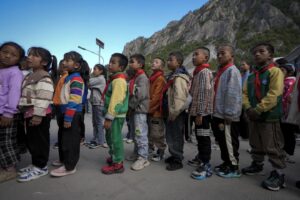

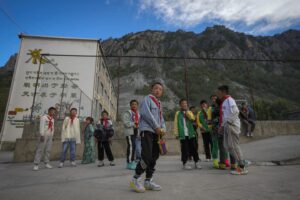
Sociologist Yang Miaoyan in 2017 published her findings: “For most of the min kao min students and the inland Tibet school graduates, the four-year stay at MUC is not only a process of professional knowledge learning, but also a process of ethnic identity searching. In this specific context where ethnic cultures are appreciated and ethnic differences are stressed, the minority students are constantly reminded and made aware of their distinctive cultures and differences from other ethnic groups. These students are actively engaged in different kinds of activities, programs, and events, to learn their ethnic culture, as a way to search for their ethnicities, to empower themselves academically, or to make up for their past loss of Tibetan culture. In addition, they are consciously sending out messages on occasions to call for the attention and cooperation of their “ethnic compatriots,” to develop the Tibetan culture and build a better future for the Tibetan regions.
“Different patterns of ethnic identity construction have been found among these students based on their tracks of schooling in pre-university education. For the Tibetan studies min kao min students, being a Tibetan means assuming an ethnic mission of promoting Tibetan language and culture. These students come from a diversity of Tibetan regions. The educational trajectory of these students reflects a strong link with Tibetan language and culture. Ever since primary school, they have taken Tibetan as a main subject. Their pathway at MUC is much clearer as they are expected to “assume teaching and research work in Tibetan language and literature,” or “work in departments or offices of the party and government, news propaganda, culture and arts, and religious management.” (Undergraduate Training Scheme, 2010 version) All the professional courses that they have taken at MUC are closely related to their Tibetan ethnicity.
“Hence, the four-year study at MUC has cultivated a deep understanding of their ethnic cultural heritage. Students with good academic performance are highly appreciated by their classmates and other ethnic compatriots because they are considered to have acquired rich knowledge of and solid understanding about Tibetan culture. The mentality that has been fostered during their education at MUC can be described as, “We are learning our own culture and it is relevant to our future work.” These students are actively engaged in activities to promote the learning of Tibetan language and culture among their Tibetan compatriots. They are the main initiators, organizers, and coordinators of many Tibetan student activities, programs, and events at MUC. They are learning to be Tibetan cultural preservers and promoters at MUC.
“For the non–Tibetan studies min kao min students, being a Tibetan embodies having a different physical appearance, wearing different clothing, engaging in different religious practices, holding different cultural beliefs, and generally underachieving academically in Han-dominant settings. These students are all from TAR. Since they were secondary school students when the Lhasa Unrest occurred, their ethnic consciousness was awakened in Tibet. However, it is at MUC that their Tibetan identity has become increasingly salient and reinforced.
SUCCEED AND BE DAMNED
“These students have been assigned to classes with the Han Chinese. Their daily communications are mostly with the Han students, although their reported good friends are usually Tibetans. These students are constantly reminded of the distinctions between the Tibetans and non-Tibetans in their everyday communications and interactions. In the Han-dominant classes where Tibetan culture is marginalized and the value of the Tibetan language is downplayed, the lack of relevant cultural and linguistic capital has resulted in their generally poor academic performances.
“Differing from the Tibetan studies min kao min students, no positive link has yet been built between “Tibetan ethnicity” and “good academic performance.” In contrast, Tibetan students with better academic performance may be discriminated against by their [Tibetan] ethnic compatriots, as good academic performance is easily interpreted as “acculturation or assimilation to Han Chinese culture.” As a way to empower themselves and also to search for their own ethnic identities, these students select some courses that are related to Tibetan language and culture. Their general high scores in these courses may further confirm that the lack of cultural relevance is the main reason for their poor performance in other courses.
“Strong ethnic identity” and “poor academic performance” are two frequently made external categorizations assigned by the non-Tibetan teachers and students. At MUC, these students learn a different identity, that of Tibetans who are not capable of competing with the Han students. For most of the inland Tibet school graduates, being Tibetan means having a reflective awareness of their cultural and language loss due to their dislocated schooling and a determination to make up for the past by innovatively initiating, organizing, or participating in Tibetan cultural programs. Since many of them were selected among the best primary graduates in Tibet between the ages of twelve and fourteen to accept secondary education in inland cities in China, a different categorical identity as a Tibetan has been fostered in the alien context. Students reported uncomfortable and unpleasant experiences of prejudice and being discriminated against during dislocated schooling, although they received a superior education and they appreciated their teachers’ care.
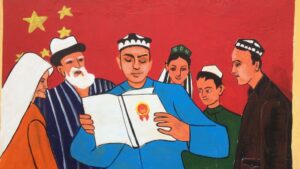
“Since these students have stayed in inland longer, they generally know the Han Chinese culture better than the min kao min students do. Yet as the subject of Tibetan was downplayed inland education, these students’ Tibetan was generally poorer than that of the min kao min students. They hold quite reflective attitudes concerning both Tibetan and Chinese culture. The identity as inland Tibet school graduates is entrenched in their self-ethnic identification. The dislocated inland schooling has not cultivated attachment to inland cities and nevertheless has activated strong nostalgia for Tibetan home regions. Being aware of their past losses in Tibetan language and culture, these students are innovatively establishing programs by integrating technology and the Internet to promote Tibetan culture and language, often with the coordinated efforts of the min kao min students. The inland Tibetan student network is very important for the formation of unity within the Tibetan group in Beijing. For most of the min kao han students, being a Tibetan is simply a symbolic identity that they sometimes utilize to gain preferential treatments. These students are the most assimilated. As they have been immersed in Chinese culturalism since they were small, they are quite estranged from the Tibetan culture. The majority of them neither speak nor write Tibetan.”[15]
This grouping of Tibetans enrolled at Minzu University tells us the only Tibetan students not yearning to deepen their heart-to-heart, mind-to-mind connections with Tibetan culture are the min kao han, those who had a completely Han education throughout childhood. The other three groups had at least some embodied experience of the embrace of Tibetan culture and yearn for more.

This is the lesson well learned by the designers of the new Ethnic Policy 2.0, a brutal tearing apart of family at an early age is a necessity, now compulsory for all Tibetan families except the few living in towns where a centralised school is nearby.
There is much we can learn from understanding the aspirations and anxieties of the min kao min, drawn to the promise of modernity and wealth if they identify as Chinese, yet also experiencing racist disdain and jealousy from the Han who surround them; while at the same time yearning to reconnect to Tibetan family life, and a culture that values compassion more than competition.
The designers of the new assimilationist 2.0 curriculum intensely studied the successes and failures of the various min kao min graduates from Neidi Xizangban hinterland schools, and from the minority nationality universities. They didn’t need sociologists of education to tell them the elaborate system for persuading bright young Tibetans to see themselves as Chinese had largely failed, especially in crucial moments such as 1987 or 2008, when it was not possible to juggle both identities.
Ethnic policy 2.0 is a complete reset, sweeping aside programs intended to incentivise and seduce Tibetans to become an elite, a new ruling class, once back in Tibet and in command but always under Han Chinese control. There are plenty of Tibetans in senior positions in the system of governmentality China imposes on Tibet, who do benefit in the short term, as bricks in the wall of Chinese power. They have privileged access to wealth creation, both salaried and corruptly. George Schaller writes of a ranking Tibetan cadre who, in his office, performs the right words on the necessity of protecting wildlife, whose SUV parked outside the office, is filled with just-slain antelopes. Woeser describes Tibetan cadres who expel the nuns who for centuries have maintained a hot spring as a refuge health spa for the chronically ill, turning it into an exclusive resort for the rich. Just two of countless examples.
Yet the Neidi Xizangban senior schools for Tibetans in the Chinese hinterlands, and the minzu daxue universities had a flip side: overt Han racist contempt, resentment and jealousy of the favoured treatment for Tibetans provided by the party-state’s ethnic policy 1.0.
Any Tibetan cadre or entrepreneur graduate of this system, once back in Tibet, always knew they were never fully trusted, and were kept under humiliating surveillance for any overt sign of still being Tibetan at heart; hence the many rules forbidding belief in Buddhism, doing kora circumambulation of sacred places etc etc.
For graduates of the Neidi Xizangban/minzu daxue system the balancing act was always precarious, as it was also for Buddhist teachers who found Han devotees flocking to them. How to be both Tibetan and Chinese, amid suspicion from both directions that you are selling out? It was always a juggle, always provisional, always a sacrifice requiring deferred fulfilment, for example the dream that when I reach cadre retirement age, with money in the bank, I can then at last devote my old age to wholly Tibetan pursuits, a religious life of preparation for the next. Yearning postponed.
At crucial moments, as in 1987 and 2008, juggling was no longer possible, everyone had to take a side. Han suspicions were confirmed: when it comes to the crunch, you can’t trust a Tibetan who has worked loyally for the party-state to stay loyal. At heart, Tibetans who have embodied experience of Tibetan family life and childhood, will revert to being first and foremost Tibetan, when circumstances make choosing a necessity. This is what generated ethnic policy 2.0.
FIVE THOUSAND YEARS OF EXCELLENT CHINESENESS
The assimilation campaign may struggle, because the textbook Pan Yue has written, which must be compulsorily digested by all minzu university students, is a grossly oversimplified cartoon caricature of not only Han-Tibetan relations, but of core Han history. Pan Yue is so determined to portray China’s unbroken, globally unique 5000 years of continuity, he must erase, elide, slide past the many ruptures, catastrophes, invasions, conquests, civil wars and discontinuities between dynasties. Using the past to serve the present is a Chinese tradition, but when the past is packaged into a travesty, it is not only Tibetans who are impoverished, so too the Han, starting with the foundational but mythical Yellow Emperor, who is now presented as a historic personage.
Pan Yue’s biggest obstacle is the Qing dynasty of alien Manchu rulers for 267 years, until in 1911, the dynasty collapsed. In the master narrative of official histories of all the dynasties, written and promoted by the official annalists of the court, the Qing are China’s 25th dynasty, and all previous dynasties do have an officially approved history.
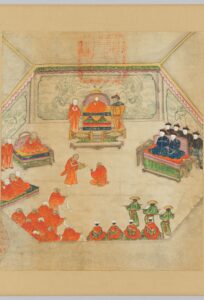
The custom is that the successor dynasty writes the history of its predecessor, which it overthrew. The present CCP dynasty has struggled for decades to write its authoritative history of the Qing, More than a century after the Qing collapse, there is still no official version of the rise and fall of the Manchu Qing nomadic horsemen who swept in from the north and conquered China, sweeping on into Tibet and Mongolia and the Islamic far west that then became Xinjiang.
Inherent in any dominant discourse defining the Qing is a deep dilemma. It is essential that the mythos of unbroken continuity be perpetuated, which is achieved by denying the Manchu warriors on horseback were alien, insisting they were so dazzled by the magnificence of Chinese civilisation, they quickly became wholly Chinese in every way. This move requires contortions and total amnesia towards sources that complicate, notably the deep historical records of the Manchu, the Mongols and the Tibetans, all literate civilisations that have their own archives, their own version of history.
A major part of the CCP’s problem is the imperative of emphasising continuity across successive regimes. The triumphant new regime could enact the dictum that history is written by the winners, but in China it is also important to emphasize those 5000 unbroken years.
It may be true that the mysterious, impersonal heaven withdraws its mandate and a dynasty falls, then the heaven confers its mandate of legitimacy on the incoming dynasty, but continuity matters most of all.
Tricky. Was 1911 an anti-Manchu revolution? Were the Manchu, backed by their all-Manchu armies, hated foreigners toppled in 1911? If so, revolutions are justified, both in 1911 and 1949 and in the future? Despite the historic evidence, that is not a narrative the CCP regime wants. No scenario of China’s future terrifies the CCP regime more than the possibility of a popular uprising against corruption and concentrations of wealth, that legitimates itself by claiming 1949 and 1911 as its lineage. Were the Manchu actually Chinese, in every way? Much more palatable.
This creates enormous difficulties for the Tibetans, obscuring the delicate diplomatic dance between Qing emperors and charismatic Tibetan lamas, over centuries, a game played not by modern concepts of game theory statecraft and geopolitics.[16]
FIRING THE MESSENGERS
Not only has the CCP regime struggled to find ways of fulfilling its dynastic obligation to write the official version of its predecessor, Pan Yue has been forced to sack the historians, and the prestigious institution that for decades has wrestled with the Qing paradox, and start over again with a new, safer pair of hands.
In 2023 a pro-CCP newspaper Sing Tao, under the headline “Failed to pass political review, “History of Qing Dynasty” hits a snag” reported: “In 2002, the central government decided to compile ‘History of Qing Dynasty’, which was presided over by the National Qing History Compilation Committee.
“This is a major academic and cultural project, with thousands of experts and scholars participating, In September 2018, the draft of “History of Qing Dynasty” was submitted to the central government.
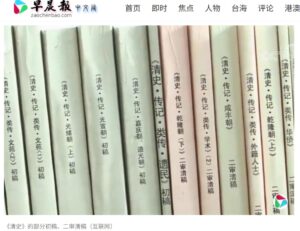
“In 2019, the central government entrusted the newly established Institute of Chinese History of the Chinese Academy of Social Sciences to review it and set up a review work leading group. In June this year [2023], CCTV reported that the review of the 106 volumes of “History of Qing Dynasty” with a total of 32 million words has been completed after nearly two years.
“However, Chinese-American professor Zhang Taisu of Yale Law School recently saying, ‘The complete manuscript of the Qing History Project did not pass the political review because it was ‘too much influenced by the new Qing History abroad.’
“In 2019, the People’s Daily, a Chinese Communist Party media outlet, published a long article criticizing the New Qing History for “introducing the theoretical variant of foreign historical nihilism in the field of Qing history research into China.”
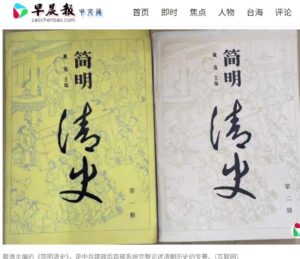
Commanding researchers to close their minds to multiple perspectives is chauvinist, reactionary. Some day, like the Cultural Revolution decade, this time will be seen as a period of rigid imposition, from above, of ideological narrow mindedness that stifled originality, complexity, real world recognition of how past and present actually are.
Right now, no-one dares say this, but a few brave voices are speaking up.
| “Despite several attempts to compile Qing History 清史, efforts by Chinese historians continue to see setbacks, with China’s ideological security on the line.
“In 2002, the Chinese Communist Party (CCP) initiated the epic historical compilation Qing History (《清史》), hailed as China’s “twenty-fifth history” (第二十五史). After 16 years of compilation, the manuscript was submitted for review, but progress has stalled since. In recent years, the manuscript is said to have been severely criticised by the CCP, with the project deemed a “failed endeavour”. This has raised concerns that Beijing is tightening its control of historical narrative to advance its territorial, ethnic, religious and diplomatic objectives. |
| “While the review of Qing History remains at a standstill, the Chinese Academy of Social Sciences (CASS) established the Qing History Research Centre in Beijing on 21 March 2025. This is seen as part of China’s efforts to confront the intensifying geopolitical competition..
“The centre aims to form a national research team of top Qing historians in China, which the CCP can trust to deepen and accomplish China’s Qing historical research. It will also innovate research methodologies to gain a firm control of the global narrative in Qing historical research, so as to communicate the correct historical perspective and effectively convey the history of the Qing dynasty. The centre looks to build China’s independent knowledge system for Qing historical research and establish a Chinese historiography of Qing historical studies, which will take a clear stand against historical nihilism and guide Qing historical research in the correct direction. “It is envisaged that the important responsibility of the compilation of Qing History will be transferred from Renmin University’s Institute of Qing History to the CASS’s Qing History Research Centre. “Prior to this, the most authoritative research institution of Qing history in China is the Institute of Qing History at the Renmin University of China (RUC), which has existed for 47 years. Among its renowned historians are Dai Yi, Li Wenhai and Wang Sizhi, who shouldered the heavy responsibility of compiling Qing History. “CCP’s three attempts to compile Qing History “Traditionally, each dynasty or era in China compiles its predecessor’s official history. So far, China has produced 24 historical documentations, collectively known as The Twenty-Four Histories, beginning with the legendary Yellow Emperor and ending with Ming dynasty’s Emperor Chongzhen. “After the demise of the Qing dynasty over a century ago, Qing History remains unpublished. Since its rise to power in 1949, the CCP’s efforts to compile Qing History have met with repeated setbacks, resulting in three unrealised attempts. “In the early days of the founding of the People’s Republic of China (PRC), one of the CCP’s founders Dong Biwu had proposed compiling Qing History, supported by Mao Zedong and Zhou Enlai. However, the project was dropped due to the Great Famine from 1959 to 1961. “The Qing History compilation project made it to the PRC’s agenda in the autumn of 1965. At Premier Zhou Enlai’s behest, Vice Minister of the CCP’s Central Propaganda Department Zhou Yang convened a meeting and established the Institute of Qing History at the RUC [Renmin University]. Seven scholars, including Dai Yi, who was regarded as the leading authority in Qing history, were appointed as members of the editorial committee. However, the plan was abandoned due to the Cultural Revolution. 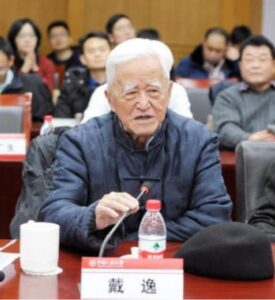 “In 1978, the RUC was re-established and the Institute of Qing History was officially started, with Dai Yi appointed as its director. During this time, Dai Yi spent seven years on the general historical overview of the Qing dynasty and compiled Jianming Qingshi (《简明清史》, Concise Qing History), the first complete, systematic study of the history of the Qing dynasty since the PRC’s founding. “These new perspectives started to challenge the concepts of the “great unification”, “China’s identity” and “sinicisation”, and resulted in Qing history becoming politically sensitive within China. “The West’s ‘new Qing History.” During China’s reform and opening up in the 1990s, a wave of historiography in “new Qing History” research emerged in Sinology studies in the US, with Western scholars focusing on archival material in non-Chinese language sources. They emphasised the Qing dynasty’s distinct Manchu identity and its differences from the previous dynasties that ruled the central plains. Instead of recognising the Qing dynasty as another dynasty in China, they argued that it is not China, and that China was only a part of the Qing empire. “When the CCP once again prioritised the battle for the narrative on Qing history at the start of the 21st century, the largest national cultural project since the PRC’s founding was finally set in motion. “In August 2002, the CCP Central Committee and the State Council decided that the National Qing History Compilation Committee, headed by Dai Yi, the honorary director of the Institute of Qing History at the RUC, would commence the Qing History compilation project. More than 2,000 Qing history scholars in China participated in the effort. “In September 2018, the Qing History manuscript was submitted to the Central Committee, which was then sent to the newly established Chinese Academy of History under the CASS for review in the following year. In June 2023, state media CCTV reported that the review of the Qing History manuscript with 106 volumes of 32 million Chinese characters — four times the length of Draft History of Qing (《清史稿》) compiled during the era of the ROC — had been preliminarily completed after nearly two years. 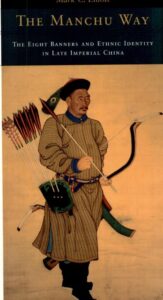 “The book was described as giving a strong riposte to the relevant erroneous remarks from New Qing History and highlighting the indisputability of Qing’s status as a dynasty in China. However in November 2023, Yale Law School Chinese-American Professor Zhang Taisu cited a reliable source and wrote on social media, that “the Qing History project… has now been put on ice because higher authorities deemed the draft… to be politically unacceptable… Specifically, the project ‘was overly influenced by the New Qing History’. This is quite the shocking claim, as most of the project leaders have spent their entire careers vehemently attacking the New Qing History… now it’s all gone to waste due to political incorrectness.” “As early as 2019, state media People’s Daily published a lengthy signed article that emphasised the Qing historical research’s link to ideological security. It also criticised New Qing History for “bringing foreign historical nihilism as a theoretical variant into Qing historical research in China”. “During a meeting on cultural inheritance and development in Beijing in June 2023, CCP General Secretary Xi Jinping emphasised that “Chinese civilisation is distinguished by its unity” and “has seen its various ethnic cultures coming together to create a cohesive whole and remaining tightly knit even in the face of serious setbacks. It shapes a common belief that China’s territorial integrity must always be preserved, the country must never be allowed to descend into turmoil, our nation must always remain united, and our civilisation must never be interrupted. It firmly underscores the notion that national unity always remains at the core of national interests…”. “Soon afterwards, the Chinese Academy of History under CASS, which was responsible for reviewing the Qing History manuscript, produced a publication of 1.1 million Chinese characters entitled History of National Unification in Qing Dynasty (《清代国家统一史》). The book was described as giving a strong riposte to the relevant erroneous remarks from New Qing History and highlighting the indisputability of Qing’s status as a dynasty in China. “Sweeping criticisms of the Qing History manuscript. The role of the Qing dynasty in this narrative is crucial to the CCP, which claims to have saved China from its “century of humiliation” inflicted by foreign powers. According to informed sources cited by The Wall Street Journal, the vetters believe that the Qing History manuscript should emphasise that the Qing dynasty ruled over a unified multi-ethnic nation. This narrative would justify the legitimacy of the CCP’s current rule over vast territories inhabited by the Mongols, Tibetans, Uyghurs and other non-Han ethnicities. “Pamela Crossley, a specialist on the Qing empire at Dartmouth College, stated that the top CCP leadership opposes portraying the Qing dynasty as “an empire of conquest”, as this could incite separatist sentiments in frontier regions such as Tibet and Xinjiang, as well as strengthen calls for “Taiwan independence”. She added that according to the CCP leadership, there have been no conquests in Chinese history, and only happy unifications and people aspiring to be Chinese.”[17] “ ‘China’s unity must be emphasised by unwaveringly upholding the common belief that China’s territorial integrity must be preserved, that China must never be allowed to descend into turmoil, that China must always remain united, and that the Chinese civilisation must never be interrupted.’ — Pan Yue, Director, National Ethnic Affairs Commission “The concept of forging a strong consciousness in the Chinese ethnic communities is currently the central theme of the CCP’s work on ethnicities. Pan Yue, the second Han Chinese director of the National Ethnic Affairs Commission in nearly 70 years, wrote an article in the Central Committee’s Qiushi Journal on 16 March 2025. He emphasised that forging a strong consciousness in the Chinese ethnic communities, an important component of Xi’s cultural ideology, is of great significance. He stressed that it is crucial to advocate that all ethnic communities establish the correct perspective of the nation, history, ethnicity, culture and religion. “Pan Yue added that ideological struggles in ethnic communities remain acute and complex. To effectively oppose infiltration and subversion by extremist and separatist ideologies, as well as address the potential ethnic-related risks and challenges in the nation’s great rejuvenation, China must forge a strong consciousness in the Chinese ethnic communities and build a secure ideological fortress to safeguard China’s unity and ethnic cohesion. “He highlighted that this has to be rooted in Chinese civilisation. China’s unity must be emphasised by unwaveringly upholding the common belief that China’s territorial integrity must be preserved, that China must never be allowed to descend into turmoil, that China must always remain united, and that the Chinese civilisation must never be interrupted. Qing History must serve Beijing’s ethnic and territorial policies. Amid these challenges, even after 23 years of endeavour in compilation, the “twenty-fifth history” remains a distant prospect.” This article was first published in Lianhe Zaobao as “中国升级《清史》话语权争夺战?”. . |
FROM ALL ANGLES
To observers, it might seem obvious that writing the history of the Qing dynasty should involve consulting more than China’s official court annals, that Manchu, Mongol and Tibetan archives also matter, enabling a rounded picture to emerge. But this is anathema in today’s China, under Xi Jinping, its ideological conformity policed by Pan Yue.
The New Qing History 清史is officially denounced as historical nihilism, as part of the giant American plot to weaken China. Only approved sources are legitimate, and all relevant organs must rectify any straying. “The relevant departments of the State People’s Committee said that the construction of the interdisciplinary discipline of Chinese national community studies breaks the original disciplinary segregation and the limitations of western national theories through revolutionary changes in the way of knowledge production, provides more solid disciplinary and talent support for the construction of the theoretical system of the Chinese national community, expounds Chinese history, Chinese road and Chinese civilisation with autonomous and original Chinese theories, and offers a realistic path for the construction of academic disciplines empowered by the Party’s innovative theories, and promotes the formation of a Chinese national community theory system. It will also provide a practical path for the construction of academic discipline.”
This nativist insistence that Han alone can tell China’s story makes the bold claim of not only refuting New Qing History but now transcending conventional boundaries of academic disciplines. By “comprehensively applying the theories and methods of multiple disciplines such as Marxist theory, philosophy, history, ethnology, sociology, etc., and focusing on the construction of the theoretical system of the Chinese national community, and achieving positive results in theoretical research, education and teaching, and talent training.”
China is creating a new knowledge system, unique in the world, which is why Tibetans, and other minority nationality students at the minzu universities, whatever they are studying, must attune their minds to Pan Yue’s graphic novel version of China’s history, since they will be examined on their capacity to reproduce it.
Pan Yue has many battles to fight, but top priority is full assimilation of the Tibetans.
He continues his fight on all fronts. In April 2025 he lectured museum directors to fall in line with his patriotic caricature of Chinese history as a unitary single line of unbroken continuity and ethnic merging. South China Morning Post reported: “Pan Yue, director of the National Ethnic Affairs Commission, made the remarks during an event billed as the first national training class for museum directors in Beijing on Wednesday. Museums should “refute all kinds of wrong historical views, including attempts to create a binary opposition between China’s Central Plains and the border areas, between Han and non-Han groups and between Han culture and cultures of ethnic minorities’, said Pan, who is ethnically Han.”
In the museums, in the universities, in the classrooms all Tibetan children must attend, this denial of Tibetan history, culture and language intensifies and intensifies. Suffocating. Pan Yue’s caricature of China’s history means all Chinese also lose the richness, complexity, contradictions of the past, but for the party-state and its culture warrior Pan Yue, the past must serve the present.
[1] http://cpc.people.com.cn/n1/2025/0423/c64387-40466546.html 李干杰主持会议。辽宁、浙江、湖南、广东、新疆等省区党委统战部和中央网信办有关负责同志作了发言。国家民委:加大对中华民族共同体交叉学科试点高校支持力度,构建自主知识体系–新闻报道-中国共产党新闻网 “National Ethnic Affairs Commission: Increase Support for Pilot Universities of the Interdisciplinary Subject of the Chinese National Community, Build an Independent Knowledge System”
[2] https://www.theguardian.com/environment/2009/mar/12/activism-china
https://dialogue.earth/en/pollution/8695-pan-yue-s-vision-of-green-china/
[3] Xi Jinping, Mobilizing Hundreds Of Millions Of Workers To Build A Great Country And Advance National Rejuvenation, Qiushi vol 16 2024 no 3
[4] Leibold, James (May 24, 2024). “New Textbook Reveals Xi Jinping’s Doctrine of Han-centric Nation-Building”. Jamestown Foundation
Glasserman, Aaron (2023-02-24). “Touting ‘Ethnic Fusion,’ China’s New Top Official for Minority Affairs Envisions a Country Free of Cultural Difference”. ChinaFile. Asia Society.
Liang, Xinlu (2024-08-05). “China’s ethnic policy chief says minority artists must focus on common identity”. South China Morning Post.
Dang, Yuanyue (2024-03-18). “‘All ethnic groups matter’: Chinese textbook spells out integration policies”. South China Morning Post.
[5] Wang, W. (2022). Fostering teachers’ multicultural competence for Chinese ethnic minority education: an analysis of teacher education programmes, syllabuses and teacher educator perceptions. Frontiers in psychology, 13, 810-240.
[6] MENA Report, Amman, 16 Sept 2023
[7] MENA Report, 12 August 2024
[8] YOU Weiqiong; DONG Xiangyun; School of Law and Sociology, Yunnan Normal University; School of Marxism, Yunnan Normal University, From Community of Responsibility to Community of Destiny: A Study of Community Construction in Borderland Governance Journal of Yunnan Minzu University (Philosophy and Social Sciences Edition云南民族大学学报(哲学社会科学版 2024, 06
[9] Wang Xiaoming New Left Review 152 2025, https://newleftreview.org/issues/ii152/articles/wang-xiaoming-on-civilization-and-its-barbarisms?pc=1670
[10] Chuanli Yang, Social-emotional competence and school bullying of adolescents in rural western China: A cross-lagged analysis, 2025, Social Behaviour & Personality: an international journal, Volume 53, Issue 3, e13943
Siyi Wang · Jinlei Qin · Ding Li, Academic Pressure or Emotional Detachment? The Complex Effect of Compulsory Boarding Due to the School Merger Policy, School Mental Health (2024) 16:1321–1335 https://doi.org/10.1007/s12310-024-09698-y
Yuanlu Ding, Latent classes and predictors of depressive and anxious symptoms in Chinese adolescents: A two-wave longitudinal survey, Children and Youth Services Review 170 (2025) 108136
[11] Miaoyan Yang, Learning to Be Tibetan: The Construction of Ethnic Identity at Minzu University of China, Lexington, 2017
[12] Huiyu Zhang & Shimeng Cai (2021) Putonghua vs. minority languages: distribution of language laws, regulations, and documents in mainland China, Ethnic and Racial Studies, 44:14, 2574-2594, DOI: 10.1080/01419870.2020.1828598
[13] Law of the People’s Republic of China on the Standard Spoken and Written Chinese Language
(Adopted at the 18th Meeting of Standing Committee of the Ninth National People’s Congress on October 31, 2000 and promulgated by Order No. 37 of the President of the People’s Republic of China on October 31, 2000)
[14] Miaoyan Yang, Jiayong Zezhen, Zhenjie Yuan and Dan Yue, Sending children to the interior cities and enabling them a promising future – a qualitative study of Tibetan parents’ educational decisions, Journal Of Multilingual And Multicultural Development, 2023, Vol. 44, No. 3, 171–184 https://doi.org/10.1080/01434632.2021.1953036
[15] Miaoyan Yang, Learning to Be Tibetan: The Construction of Ethnic Identity at Minzu University of China, Lexington Books, 2017
[16] Peter Schwieger, The Dalai Lama and the Emperor of China: A Political History of the Tibetan Institution of Reincarnation, Columbia University Press
Max Oidtmann, Forging the Golden Urn: The Qing Empire and the Politics of Reincarnation in Tibet, Columbia
[17] published in Lianhe Zaobao as “中国升级《清史》话语权争夺战?”. Singapore-based media Lianhe Zaobao, which circulates in China, is a newspaper that usually conforms to the party-state official line, but is sometimes adventurous.
